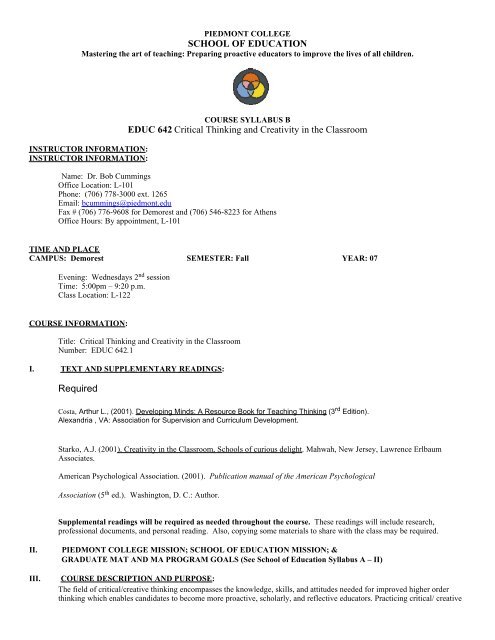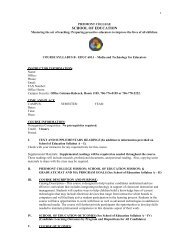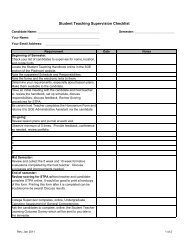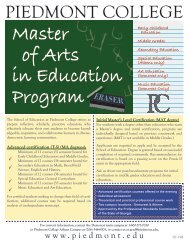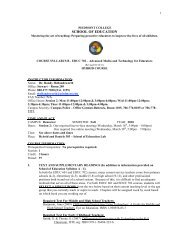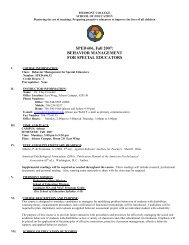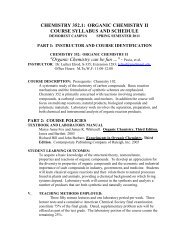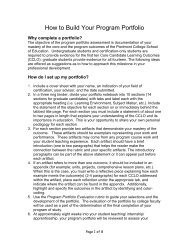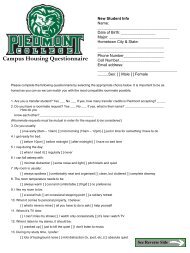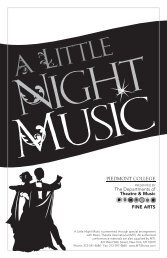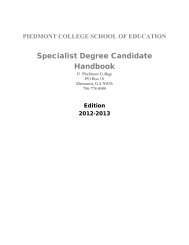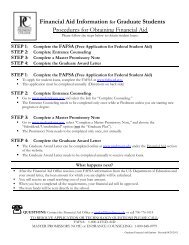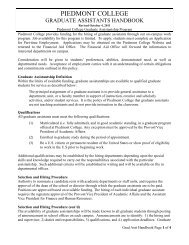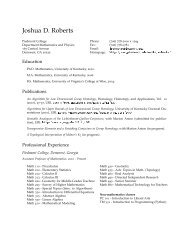EDUC 642 Critical Thinking and Creativity in the ... - Piedmont College
EDUC 642 Critical Thinking and Creativity in the ... - Piedmont College
EDUC 642 Critical Thinking and Creativity in the ... - Piedmont College
You also want an ePaper? Increase the reach of your titles
YUMPU automatically turns print PDFs into web optimized ePapers that Google loves.
PIEDMONT COLLEGE<br />
SCHOOL OF <strong>EDUC</strong>ATION<br />
Master<strong>in</strong>g <strong>the</strong> art of teach<strong>in</strong>g: Prepar<strong>in</strong>g proactive educators to improve <strong>the</strong> lives of all children.<br />
INSTRUCTOR INFORMATION:<br />
INSTRUCTOR INFORMATION:<br />
COURSE SYLLABUS B<br />
<strong>EDUC</strong> <strong>642</strong> <strong>Critical</strong> <strong>Th<strong>in</strong>k<strong>in</strong>g</strong> <strong>and</strong> <strong>Creativity</strong> <strong>in</strong> <strong>the</strong> Classroom<br />
Name: Dr. Bob Cumm<strong>in</strong>gs<br />
Office Location: L-101<br />
Phone: (706) 778-3000 ext. 1265<br />
Email: bcumm<strong>in</strong>gs@piedmont.edu<br />
Fax # (706) 776-9608 for Demorest <strong>and</strong> (706) 546-8223 for A<strong>the</strong>ns<br />
Office Hours: By appo<strong>in</strong>tment, L-101<br />
TIME AND PLACE<br />
CAMPUS: Demorest SEMESTER: Fall YEAR: 07<br />
Even<strong>in</strong>g: Wednesdays 2 nd session<br />
Time: 5:00pm – 9:20 p.m.<br />
Class Location: L-122<br />
COURSE INFORMATION:<br />
Title: <strong>Critical</strong> <strong>Th<strong>in</strong>k<strong>in</strong>g</strong> <strong>and</strong> <strong>Creativity</strong> <strong>in</strong> <strong>the</strong> Classroom<br />
Number: <strong>EDUC</strong> <strong>642</strong>.1<br />
I. TEXT AND SUPPLEMENTARY READINGS:<br />
Required<br />
Costa, Arthur L., (2001). Develop<strong>in</strong>g M<strong>in</strong>ds: A Resource Book for Teach<strong>in</strong>g <strong>Th<strong>in</strong>k<strong>in</strong>g</strong> (3 rd Edition).<br />
Alex<strong>and</strong>ria , VA: Association for Supervision <strong>and</strong> Curriculum Development.<br />
Starko, A.J. (2001). <strong>Creativity</strong> <strong>in</strong> <strong>the</strong> Classroom, Schools of curious delight. Mahwah, New Jersey, Lawrence Erlbaum<br />
Associates.<br />
American Psychological Association. (2001). Publication manual of <strong>the</strong> American Psychological<br />
Association (5 th ed.). Wash<strong>in</strong>gton, D. C.: Author.<br />
Supplemental read<strong>in</strong>gs will be required as needed throughout <strong>the</strong> course. These read<strong>in</strong>gs will <strong>in</strong>clude research,<br />
professional documents, <strong>and</strong> personal read<strong>in</strong>g. Also, copy<strong>in</strong>g some materials to share with <strong>the</strong> class may be required.<br />
II.<br />
III.<br />
PIEDMONT COLLEGE MISSION; SCHOOL OF <strong>EDUC</strong>ATION MISSION; &<br />
GRADUATE MAT AND MA PROGRAM GOALS (See School of Education Syllabus A – II)<br />
COURSE DESCRIPTION AND PURPOSE:<br />
The field of critical/creative th<strong>in</strong>k<strong>in</strong>g encompasses <strong>the</strong> knowledge, skills, <strong>and</strong> attitudes needed for improved higher order<br />
th<strong>in</strong>k<strong>in</strong>g which enables c<strong>and</strong>idates to become more proactive, scholarly, <strong>and</strong> reflective educators. Practic<strong>in</strong>g critical/ creative
th<strong>in</strong>k<strong>in</strong>g <strong>and</strong> metacognition allows c<strong>and</strong>idates to underst<strong>and</strong> <strong>the</strong>ir <strong>the</strong>oretical underp<strong>in</strong>n<strong>in</strong>gs, <strong>and</strong> to practice higher order<br />
th<strong>in</strong>k<strong>in</strong>g skills/strategies <strong>in</strong> order to improve classroom teach<strong>in</strong>g practices <strong>and</strong> life-long learn<strong>in</strong>g skills.<br />
IV.<br />
SCHOOL OF <strong>EDUC</strong>ATION OUTCOMES (See School of Education Syllabus A – IV)<br />
(C<strong>and</strong>idate Learn<strong>in</strong>g Outcomes by Program <strong>and</strong> Dispositions for All C<strong>and</strong>idates)<br />
V. COURSE OUTCOMES :<br />
What are critical th<strong>in</strong>k<strong>in</strong>g skills <strong>and</strong> why are <strong>the</strong>y necessary for effective teach<strong>in</strong>g? What is creativity <strong>and</strong> how can it be<br />
nurtured <strong>in</strong> <strong>the</strong> classroom? S<strong>in</strong>ce <strong>the</strong> early 1980’s, educators have been criticized for perpetuat<strong>in</strong>g a “rid<strong>in</strong>g tide of<br />
mediocrity” by requir<strong>in</strong>g of students primarily rote memorization of disassociated facts <strong>and</strong> details. Today, most educators<br />
agree that <strong>the</strong> focus of learn<strong>in</strong>g should be on how to use <strong>in</strong>formation for creative problem solv<strong>in</strong>g, analysis, evaluation, <strong>and</strong><br />
o<strong>the</strong>r higher order tasks. At <strong>the</strong> conclusion of <strong>the</strong> course, students should be able to:<br />
1) (CLO 2,) Describe a <strong>the</strong>ory of knowledge. What is knowledge <strong>and</strong> how do we acquire it? (To be reflected upon<br />
<strong>and</strong> revised throughout <strong>the</strong> course.)<br />
2) (CLO 2,) Generate a def<strong>in</strong>ition of critical th<strong>in</strong>k<strong>in</strong>g drawn from critical exam<strong>in</strong>ation of o<strong>the</strong>rs’ views <strong>and</strong> of one’s<br />
own life experiences. (To be reflected upon <strong>and</strong> revised throughout <strong>the</strong> course.)<br />
3) (CLO 2,) Generate a def<strong>in</strong>ition of creativity drawn from o<strong>the</strong>rs’ views <strong>and</strong> from one’s own experiences. (To be<br />
reflected upon <strong>and</strong> revised throughout <strong>the</strong> course.)<br />
4) (CLO 1, 2, 4, 9,) Describe/<strong>in</strong>terpret <strong>the</strong> <strong>the</strong>oretical bases of <strong>the</strong> th<strong>in</strong>k<strong>in</strong>g skills movement, <strong>in</strong>clud<strong>in</strong>g characteristics<br />
of <strong>the</strong> learner that very much affect critical th<strong>in</strong>k<strong>in</strong>g—e.g., attitudes/beliefs, learn<strong>in</strong>g style, motivation,<br />
metacognitive knowledge, etc.<br />
5) (CLO 2, 3, 5,) Describe/apply <strong>the</strong> research – based evidence on factors that stimulate creative problem solv<strong>in</strong>g <strong>in</strong><br />
<strong>the</strong> classroom <strong>and</strong> describe how to use those factors at <strong>the</strong> elementary level.<br />
6) (CLO 2,) Exhibit improved critical/creative th<strong>in</strong>k<strong>in</strong>g skills <strong>in</strong> <strong>the</strong> areas of application, analysis, syn<strong>the</strong>sis,<br />
evaluation, <strong>and</strong> problem solv<strong>in</strong>g/decision mak<strong>in</strong>g.<br />
7) (CLO 1, 2, 3, 9,) Exhibit knowledge of models for teach<strong>in</strong>g higher order th<strong>in</strong>k<strong>in</strong>g skills, <strong>in</strong>clud<strong>in</strong>g teach<strong>in</strong>g<br />
metacognitive strategies.<br />
8) (CLO 2, 3, 6,) Evaluate higher order th<strong>in</strong>k<strong>in</strong>g skills of elementary students.<br />
9) (CLO 2, 4, 7, 10,) Teach <strong>the</strong> class about one critical or creative th<strong>in</strong>k<strong>in</strong>g program or strategy that is designed to<br />
accomplish its goals effectively.<br />
VI. COURSE POLICIES & PROCEDURES: (In addition to <strong>in</strong>formation provided on School of Education Syllabus A –<br />
VI).<br />
1. Class Attendance & Participation<br />
2. Written Work<br />
3. Academic Integrity<br />
4. Special Considerations (See School of Education Syllabus A – VI)<br />
5. Cell Phone Usage<br />
VII.<br />
INSTRUCTIONAL METHODS, DESCRIPTION OF ASSIGNMENTS, AND FIELD EXPERIENCES:<br />
1. Instructional Methods: See School of Education Syllabus A – VII.<br />
2. Description of Assignments:<br />
Read<strong>in</strong>gs from <strong>the</strong> assigned texts will be <strong>the</strong> focus for discussions, writ<strong>in</strong>gs, <strong>and</strong> group activities. Please read <strong>the</strong> assigned<br />
read<strong>in</strong>gs before com<strong>in</strong>g to class <strong>in</strong> order to facilitate quality discussions. Th<strong>in</strong>k about how <strong>the</strong> read<strong>in</strong>gs relate or could relate<br />
to your classroom teach<strong>in</strong>g experiences. Also keep <strong>in</strong> m<strong>in</strong>d that you are responsible for <strong>the</strong> read<strong>in</strong>g assignments even if we<br />
do not go over <strong>the</strong>m <strong>in</strong> class.<br />
In-class Problem Solv<strong>in</strong>g Exercises: These exercises will be collected on a variable schedule throughout <strong>the</strong><br />
semester <strong>and</strong> will be worth up to 10% of <strong>the</strong> total grade. In-class exercises are formative evaluations <strong>and</strong> are also<br />
designed to assess class participation. They are like pop quizzes; students must be present that day <strong>in</strong> order to earn<br />
po<strong>in</strong>ts. There are no make-up exercises. STUDENTS ARE EXPECTED TO HAVE READ THE ASSIGNED<br />
MATERIAL BEFORE COMING TO CLASS.<br />
Students will select an au<strong>the</strong>ntic problem <strong>and</strong> devise a creative way to solve it. Students should submit a paper<br />
<strong>in</strong>clud<strong>in</strong>g <strong>the</strong> follow<strong>in</strong>g: a def<strong>in</strong>ition of <strong>the</strong> problem, research regard<strong>in</strong>g what is known about <strong>the</strong> problem, <strong>the</strong><br />
solution selected <strong>and</strong> <strong>the</strong> rationale for its selection, <strong>and</strong> suggested ways to evaluate <strong>the</strong> effectiveness of <strong>the</strong> proposed<br />
solution. At lease three different references <strong>and</strong> an APA-style format are required. Students will present problems<br />
<strong>and</strong> creative solutions to <strong>the</strong> class <strong>in</strong> a 10-15 m<strong>in</strong>ute lesson presentation.
O<strong>the</strong>r assignments or activities may be required as deemed necessary to assure <strong>the</strong> mastery of <strong>the</strong> course objectives<br />
as stated.<br />
Assignments to Be Completed for This Course:<br />
Each c<strong>and</strong>idate is responsible for arrang<strong>in</strong>g <strong>and</strong> document<strong>in</strong>g his/her field experiences at<br />
an appropriate grade level. Keep <strong>in</strong> m<strong>in</strong>d that Early Childhood Majors are required to work <strong>in</strong><br />
grades P-K, 1-3, <strong>and</strong> 4-5. When select<strong>in</strong>g field experiences, be sure that you are gett<strong>in</strong>g a good<br />
representation from each of <strong>the</strong> grade level areas for documentation of field experiences.<br />
Initial certification c<strong>and</strong>idates must document a m<strong>in</strong>imum of five hours for this course.<br />
Advanced certification c<strong>and</strong>idates must document a m<strong>in</strong>imum of two hours for this course.<br />
C<strong>and</strong>idates add<strong>in</strong>g a new field must document a m<strong>in</strong>imum of three hours.<br />
3. Field Experiences (Initial <strong>and</strong> Advanced Ceritification Tracks):<br />
Different county <strong>and</strong> city school systems require that specific field experience procedures <strong>and</strong> forms be used for placement of<br />
c<strong>and</strong>idates <strong>in</strong> <strong>the</strong>ir schools. Also, certa<strong>in</strong> field experience placement forms may be required by your college professor. Make<br />
sure you are us<strong>in</strong>g <strong>the</strong> appropriate placement request form(s) for <strong>the</strong> field experiences <strong>in</strong> this course.<br />
VIII.<br />
RESOURCES:<br />
Babbie, E. (2002). The Basics of Social Research (2nd ed.). Belmont, CA: Wadsworth.<br />
Baxter Magolda, M. (1992). Know<strong>in</strong>g <strong>and</strong> reason<strong>in</strong>g <strong>in</strong> college: Gender-related patterns <strong>in</strong> students’<br />
<strong>in</strong>tellectual development. San Francisco: Jossey-Bass.<br />
Bloom, B. S., et al. (1956). Taxonomy of Educational Objectives: The Classification of Educational Goals.<br />
New York: David McKay.<br />
Bok, D. (2005, December 18). Are <strong>College</strong>s Fail<strong>in</strong>g? Higher Ed Needs New Lesson Plans. The Boston Globe,<br />
p. K12.<br />
Brookfield, S. D. (1987). Develop<strong>in</strong>g <strong>Critical</strong> Th<strong>in</strong>kers. San Francisco: Jossey-Bass.<br />
Brookfield, S. D. (1995). Becom<strong>in</strong>g a <strong>Critical</strong>ly Reflective Teacher. San Francisco: Jossey-Bass.<br />
Burton, J., Horowitz, R., & Abeles, H. (2000). Learn<strong>in</strong>g <strong>in</strong> <strong>and</strong> through <strong>the</strong> arts: The question of transfer.<br />
Studies <strong>in</strong> Art Education, 41(3), 228-57.<br />
ACT (2006-2007a). CAAP Technical H<strong>and</strong>book, 2006-2007: Assess<strong>in</strong>g Academic Achievement <strong>in</strong> Read<strong>in</strong>g,<br />
Writ<strong>in</strong>g, Ma<strong>the</strong>matics, Science, <strong>and</strong> <strong>Critical</strong> <strong>Th<strong>in</strong>k<strong>in</strong>g</strong>. Iowa City, IA: ACT.<br />
ACT (2006-2007b). CAAP Guide to Successful General Education Outcomes Assessment, 2006-2007. Iowa<br />
City, IA: ACT.<br />
Carr, K. S. (1990). How Can We Teach <strong>Critical</strong> <strong>Th<strong>in</strong>k<strong>in</strong>g</strong>? Retrieved on 6/6/2006 from<br />
http://www.ericdigests.org/pre-9218/critical.htm.<br />
Collegiate Assessment of Academic Proficiency. Retrieved 1/22/07 from<br />
http://www.act.org/caap/tests/th<strong>in</strong>k<strong>in</strong>g.html.
Collegiate Learn<strong>in</strong>g Assessment. Retrieved 11/14/06, from http://www.cae.org/content/pro_collegiate.htm.<br />
Cotton, K. (1991). Close-Up #11: Teach<strong>in</strong>g th<strong>in</strong>k<strong>in</strong>g skills. Retrieved 1/14/2007, from<br />
http://www.nwrel.org/scpd/sirs/6/cu11.html.<br />
Cozby, P. (2001). Methods <strong>in</strong> behavioral research, (8 th ed.). New York: McGraw Hill.<br />
Donald, J. (2002). Learn<strong>in</strong>g to th<strong>in</strong>k: Discipl<strong>in</strong>ary perspectives. San Francisco: Jossey-Bass.<br />
Ennis, R. (1961) Assumption-f<strong>in</strong>d<strong>in</strong>g. In O. Smith <strong>and</strong> R. Ennis (Eds.), Language <strong>and</strong> concept <strong>in</strong> education<br />
(pp. 161-178). Chicago: R<strong>and</strong> McNally.<br />
Ennis, R.. (1989) <strong>Critical</strong> th<strong>in</strong>k<strong>in</strong>g <strong>and</strong> subject specificity: clarification <strong>and</strong> needed research. Educational<br />
Researcher, 18(3), 4-10.<br />
Ennis, R., & Weir, E. The Ennis-Weir <strong>Critical</strong> <strong>Th<strong>in</strong>k<strong>in</strong>g</strong> Essay Test, 1983-85. California: Midwest<br />
Publications.<br />
Facione, P., Giancarlo, C., Facione, N., & Ga<strong>in</strong>en, K. (1995). The disposition toward critical th<strong>in</strong>k<strong>in</strong>g. Journal<br />
of General Education, 44(1), 1-25.<br />
Franks, C. (1999). Ethnographic eyes: A teacher’s guide to classroom observation. Portsmouth, NH:<br />
He<strong>in</strong>emann.<br />
Gardner, Lion. (1998). Why We Must Change: The Research Evidence. Thought & Action, 14(1), 71-88.<br />
Ghezzi, P. <strong>and</strong> MacDonald, M. (2005, August 31). Silver l<strong>in</strong><strong>in</strong>gs <strong>in</strong> SAT clouds: Georgia's score rises, still tied<br />
for last place. Atlanta Journal-Constitution, p. 1B.<br />
Giddens, J., & Gloeckner, G., (2005). The relationship of critical th<strong>in</strong>k<strong>in</strong>g to performance on NCLEX-RN.<br />
Journals of Nurs<strong>in</strong>g Education, 44(2), 85-89.<br />
Giedd, J., Blumenthal, J., Jeffries, N., et al. (1999). Bra<strong>in</strong> development dur<strong>in</strong>g childhood <strong>and</strong> adolescence: A<br />
longitud<strong>in</strong>al MRI study. Nature Neuroscience, 2(10), 861-63.<br />
Inhelder, B., & Piaget, J. (1958). The growth of logical th<strong>in</strong>k<strong>in</strong>g from childhood to adolescence. New York:<br />
Basic Books.<br />
The International <strong>Critical</strong> <strong>Th<strong>in</strong>k<strong>in</strong>g</strong> Read<strong>in</strong>g <strong>and</strong> Writ<strong>in</strong>g Test. Retrieved 1/22/07 from<br />
http://www.criticalth<strong>in</strong>k<strong>in</strong>g.org/assessment/ICAT-<strong>in</strong>fo.cfm.<br />
Kenny, R. W. (1998). Re<strong>in</strong>vent<strong>in</strong>g Undergraduate Education: A Bluepr<strong>in</strong>t for America’s Research Universities.<br />
Retrieved April 2006 from http://naples.cc.sunysb.edu/Pres/boyer.nsf/<br />
K<strong>in</strong>cheloe, J., & Weil, D. (2004). <strong>Critical</strong> th<strong>in</strong>k<strong>in</strong>g <strong>and</strong> learn<strong>in</strong>g: an encyclopedia for parents <strong>and</strong> teachers.<br />
Westport, CT: Greenwood Press.
Klaczynski, P. (2001). Analytic <strong>and</strong> heuristic <strong>in</strong>fluences on adolescent reason<strong>in</strong>g <strong>and</strong> decision-mak<strong>in</strong>g. Child<br />
Development, 72(3), 844-861.<br />
Lampert, N. <strong>Critical</strong> th<strong>in</strong>k<strong>in</strong>g dispositions as an outcome of art education. Studies <strong>in</strong> Art Education, 47(3),<br />
215-228.<br />
Langer, J. (1992). <strong>Critical</strong> th<strong>in</strong>k<strong>in</strong>g <strong>and</strong> English language arts <strong>in</strong>struction. Arl<strong>in</strong>gton, VA: ERIC.<br />
Lauer, T. (2005). Teach<strong>in</strong>g critical-th<strong>in</strong>k<strong>in</strong>g skills us<strong>in</strong>g course content materials: A reversal of roles. Journal<br />
of <strong>College</strong> Science Teach<strong>in</strong>g, 34(6), 34-37.<br />
Lehmann, I.J. (1963). Changes <strong>in</strong> critical th<strong>in</strong>k<strong>in</strong>g, attitudes, <strong>and</strong> values from freshman to senior years.<br />
Journal of Educational Psychology, 54(6), 305-315.<br />
Lenroot, R. K., & Giedd, J. N. (2006). Bra<strong>in</strong> development <strong>in</strong> children <strong>and</strong> adolescents: Insights from<br />
anatomical magnetic resonance imag<strong>in</strong>g. Neuroscience & Biobehavioral Reviews, 30(6), 718-729.<br />
Lunsford, A., Lunsford, J., Ruszkiewicz, J., <strong>and</strong> Walters, K. (2001). Everyth<strong>in</strong>g’s An Argument (2 nd ed.).<br />
Boston: Bedford/St. Mart<strong>in</strong>’s.<br />
McEwen, B. C. (1994). Teach<strong>in</strong>g critical th<strong>in</strong>k<strong>in</strong>g skills <strong>in</strong> bus<strong>in</strong>ess education. Journal of Education for<br />
Bus<strong>in</strong>ess, 70(2), 99-104.<br />
McMillan, J.H. (1986). Enhanc<strong>in</strong>g college students’ critical th<strong>in</strong>k<strong>in</strong>g: A review of studies. Research <strong>in</strong> Higher<br />
Education, 26(1), 3-29.<br />
McMorris, R. F. (1995). California <strong>Critical</strong> <strong>Th<strong>in</strong>k<strong>in</strong>g</strong> Skills Test [review]. In Conoley, J.C. <strong>and</strong> Impara, J.C.<br />
(Eds.), The Twelfth Mental Measurements Yearbook. L<strong>in</strong>coln: University of Nebraska Press.<br />
Michael, W. B. (1995). California <strong>Critical</strong> <strong>Th<strong>in</strong>k<strong>in</strong>g</strong> Skills Test [review]. In Conoley, J.C. <strong>and</strong> Impara, J.C.<br />
(Eds.), The Twelfth Mental Measurements Yearbook. L<strong>in</strong>coln: University of Nebraska Press.<br />
NRC (National Research Council of <strong>the</strong> National Academy of Sciences). (1996). National science education<br />
st<strong>and</strong>ards. Wash<strong>in</strong>gton, DC: National Academy of Sciences.<br />
Paul, R. (1992). <strong>Critical</strong> <strong>Th<strong>in</strong>k<strong>in</strong>g</strong>: Basic Questions & Answers. Retrieved on 6/2/2006 from<br />
http://www.criticalth<strong>in</strong>k<strong>in</strong>g.org/aboutCT/CTquestionsAnswers.shtml.<br />
Paul, R. & Elder, L. (2006). The <strong>in</strong>ternational critical th<strong>in</strong>k<strong>in</strong>g read<strong>in</strong>g <strong>and</strong> writ<strong>in</strong>g test. Dillon Beach, CA:<br />
Foundation for <strong>Critical</strong> <strong>Th<strong>in</strong>k<strong>in</strong>g</strong>.<br />
Paul, R., Elder, L., & Bartell, T. (1997). Our Concept of <strong>Critical</strong> <strong>Th<strong>in</strong>k<strong>in</strong>g</strong>: Why <strong>Critical</strong> <strong>Th<strong>in</strong>k<strong>in</strong>g</strong>? Retrieved<br />
on 6/2/2006 from http://www.criticalth<strong>in</strong>k<strong>in</strong>g.org/aboutCT/outConceptCT.shtml.<br />
Paul, R., Elder, L., & Bartell, T. (2004). A Brief History of <strong>the</strong> Idea of <strong>Critical</strong> <strong>Th<strong>in</strong>k<strong>in</strong>g</strong>. Retrieved on
6/2/2006 from http://www.criticalth<strong>in</strong>k<strong>in</strong>g.org/aboutCT/briefHistoryCT.shtml.<br />
Paul, R. & Elder, L. (2005). A guide for educators to critical th<strong>in</strong>k<strong>in</strong>g competency st<strong>and</strong>ards. Dillon Beach,<br />
CA: Foundation for <strong>Critical</strong> <strong>Th<strong>in</strong>k<strong>in</strong>g</strong>.<br />
Patrick, J. (1986). <strong>Critical</strong> <strong>Th<strong>in</strong>k<strong>in</strong>g</strong> <strong>in</strong> <strong>the</strong> Social Studies. Retrieved on 6/6/2006 from<br />
http://www.ericdigests.org/pre-924/critical.htm.<br />
<strong>Piedmont</strong> <strong>College</strong>. (2005a). General education curriculum: Rationale <strong>and</strong> implementation, rev. 04/06/2005.<br />
Demorest, GA: The <strong>College</strong>.<br />
<strong>Piedmont</strong> <strong>College</strong>. (2005b). Vision, Mission, Goals & Strategies, 2005-2010, rev. 05/06/2005. Demorest, GA:<br />
The <strong>College</strong>.<br />
Pogonowski, L. (1989). <strong>Critical</strong> th<strong>in</strong>k<strong>in</strong>g <strong>and</strong> music listen<strong>in</strong>g. Music Educators Journal, 76(1), 35-38.<br />
Potts, B. (1994). Strategies for Teach<strong>in</strong>g <strong>Critical</strong> <strong>Th<strong>in</strong>k<strong>in</strong>g</strong>. Retrieved on 6/6/2006 from<br />
http://www.ericdigests.org/1996-1/critical.htm.<br />
Provus, M. (1955). History <strong>and</strong> critical th<strong>in</strong>k<strong>in</strong>g. The School Review, 63(7), 393-396.<br />
Ruggiero, V. (1991). The Art of <strong>Th<strong>in</strong>k<strong>in</strong>g</strong> (3 rd ed.). New York: HarperColl<strong>in</strong>s.<br />
Ruggiero, V. (2004). <strong>Th<strong>in</strong>k<strong>in</strong>g</strong> <strong>Critical</strong>ly about Ethical Issues (6 th ed.). Boston : McGraw Hill Higher<br />
Education.<br />
SACS (Sou<strong>the</strong>rn Association of <strong>College</strong>s <strong>and</strong> Schools). (2004). H<strong>and</strong>book for Reaffirmation of Accreditation.<br />
Atlanta, GA: SACS.<br />
Schrag, F. (1988). <strong>Th<strong>in</strong>k<strong>in</strong>g</strong> <strong>in</strong> school <strong>and</strong> society. New York: Routledge.<br />
Shermis, S. Samuel (1999). “Reflective Thought, <strong>Critical</strong> <strong>Th<strong>in</strong>k<strong>in</strong>g</strong>. Retrieved on 6/6/2006 from<br />
http://ericdigests.org/2000-3/thought.htm.<br />
Staib, S. (2003). Teach<strong>in</strong>g <strong>and</strong> measur<strong>in</strong>g critical th<strong>in</strong>k<strong>in</strong>g. Journal of Nurs<strong>in</strong>g Education, 42(11), 498-508.<br />
Stewart, S., & Dempsey, L. (2005). A longitud<strong>in</strong>al study of baccalaureate nurs<strong>in</strong>g students’ critical th<strong>in</strong>k<strong>in</strong>g<br />
dispositions. Journal of Nurs<strong>in</strong>g Education, 44 (2), 81-84.<br />
Szostak, D & Robertson, J. (1996). Issues <strong>in</strong> measur<strong>in</strong>g critical th<strong>in</strong>k<strong>in</strong>g: meet<strong>in</strong>g <strong>the</strong> challenge. Journal of<br />
Nurs<strong>in</strong>g Education, 42(1), 5-11.<br />
Terenz<strong>in</strong>i, P.T., Spr<strong>in</strong>ger, L., Pascarella, E.T., & Nora, A. (2005). Influences affect<strong>in</strong>g <strong>the</strong> development of<br />
students’ critical th<strong>in</strong>k<strong>in</strong>g skills. Research <strong>in</strong> Higher Education, 36(1), 23-39.<br />
Tob<strong>in</strong>, K. (1990). Chang<strong>in</strong>g metaphors <strong>and</strong> beliefs: A master switch for teach<strong>in</strong>g? Theory <strong>in</strong>to Practice, 29(2),<br />
122-127.
Twibell, R., Ryan, M., & Hermiz, M. (2005). Faculty perceptions of critical th<strong>in</strong>k<strong>in</strong>g <strong>in</strong> student cl<strong>in</strong>ical<br />
experiences. Journal of Nurs<strong>in</strong>g Education, 44(2), 71-79.<br />
W<strong>in</strong>eberg, S. (2002). Historical th<strong>in</strong>k<strong>in</strong>g <strong>and</strong> o<strong>the</strong>r unnatural acts: Chart<strong>in</strong>g <strong>the</strong> future of teach<strong>in</strong>g <strong>the</strong> past.<br />
Philadelphia: Temple University.<br />
Yuretich, R. F. (2003). Encourag<strong>in</strong>g critical th<strong>in</strong>k<strong>in</strong>g: Measur<strong>in</strong>g skills <strong>in</strong> large <strong>in</strong>troductory science classes.<br />
Journal of <strong>College</strong> Science Teach<strong>in</strong>g, 33(3), 40-45.<br />
1. Bibliography: TBA<br />
2. Relevant Web Sites:<br />
See School of Education Syllabus A – VIII<br />
3. GACE Information:<br />
4. Admission to Teacher Education (See School of Education Syllabus A – VIII)<br />
5. Application for Certification<br />
IX.<br />
COURSE ASSESSMENT AND EVALUATION:<br />
Grade A-Superior (90-100)<br />
1. Scholarship-Strong, exceed<strong>in</strong>g requirements of <strong>in</strong>structor.<br />
2. Initiative-Contributions exceed<strong>in</strong>g <strong>the</strong> assignment, show<strong>in</strong>g <strong>in</strong>dependent resourcefulness.<br />
3. Attitude-Positive benefit to class.<br />
4. Cooperation-Forward<strong>in</strong>g all group activities, constant <strong>and</strong> spontaneous.<br />
5. Individual Improvement-Marked <strong>and</strong> Grow<strong>in</strong>g.<br />
Grade B-Good-Above Average (80-89)<br />
1. Scholarship-Accurate <strong>and</strong> complete, meet<strong>in</strong>g all requirements of <strong>in</strong>structor.<br />
2. Initiative-Good when stimulated by some desirable achievement.<br />
3. Attitude-Proper <strong>and</strong> beneficial to group.<br />
4. Cooperation-Good <strong>in</strong> group work.<br />
5. Individual Improvement-Show<strong>in</strong>g marks of progress <strong>and</strong> respond<strong>in</strong>g to stimulation.<br />
Grade C-Average (70-79)<br />
1. Scholarship-Barely meet<strong>in</strong>g assignments <strong>and</strong> show<strong>in</strong>g evidence of need of encouragement.<br />
2. Initiative-Uncerta<strong>in</strong> <strong>and</strong> apparent only at times.<br />
3. Attitude-Generally neutral but not objectionable.<br />
4. Cooperation-Not positive nor very effective <strong>and</strong> irregular.<br />
5. Individual Improvement-Very ord<strong>in</strong>ary, def<strong>in</strong>ite marks lack<strong>in</strong>g.<br />
Grade D-Below Average, Yet Pass<strong>in</strong>g (65-69)<br />
1. Scholarship-Not meet<strong>in</strong>g all assignments <strong>and</strong> requirements of <strong>in</strong>structor.<br />
2. Initiative-Lack<strong>in</strong>g.<br />
3. Attitude-Indifferent.<br />
4. Cooperation-Just fair at times <strong>and</strong> lack<strong>in</strong>g at o<strong>the</strong>r times.<br />
5. Individual Improvement-Not noticeable.<br />
Grade F-Fail<strong>in</strong>g (0-64)<br />
Work unsatisfactory <strong>and</strong> is a fail<strong>in</strong>g grade <strong>and</strong> hence not def<strong>in</strong>ed.<br />
XIII.<br />
TENTATIVE SCHEDULE<br />
Date & Day Topic Assignment Assessment<br />
Week 1<br />
What Are Higher Order<br />
<strong>Th<strong>in</strong>k<strong>in</strong>g</strong> (HOT)<br />
Skills/How Can They<br />
Be Taught?<br />
Costa, Selected<br />
read<strong>in</strong>gs<br />
Starko Chapter 1<br />
Class participation
Week 2<br />
Week 3<br />
What is Knowledge?<br />
What are <strong>the</strong> Theoretical<br />
Bases of <strong>the</strong> <strong>Th<strong>in</strong>k<strong>in</strong>g</strong><br />
Skills of Movement?<br />
Frameworks/Models/Formats<br />
for HOT<br />
Costa, Selected<br />
read<strong>in</strong>gs<br />
Starko Chapter 2<br />
Costa, Selected<br />
read<strong>in</strong>gs<br />
Starko Chapter 3<br />
Reflection paper<br />
Class participation<br />
Project plan due<br />
Class participation<br />
Week 4<br />
Week 5<br />
Week 6<br />
HOT as Metacognition<br />
Mid-term Exam<br />
HOT as Problem<br />
Solv<strong>in</strong>g <strong>and</strong> Decision<br />
Mak<strong>in</strong>g<br />
HOT as <strong>Creativity</strong><br />
PRESENTATIONS/<br />
LESSONS<br />
Costa, Selected<br />
read<strong>in</strong>gs<br />
Starko Chapter 4<br />
Costa, Selected<br />
read<strong>in</strong>gs<br />
Starko Chapter 5<br />
Costa, Selected<br />
read<strong>in</strong>gs<br />
Starko Chapter 6<br />
Reflection paper<br />
Class participation<br />
Mid-term Exam<br />
Class participation<br />
Reflection paper<br />
Class participation<br />
Week 7<br />
Week 8<br />
Teach<strong>in</strong>g HOT Skills<br />
PRESENTATION/<br />
LESSONS<br />
Evaluat<strong>in</strong>g HOT Skills/<br />
F<strong>in</strong>al Exam<br />
Papers DUE!<br />
Costa, Selected<br />
read<strong>in</strong>gs<br />
Starko Chapter 7<br />
Costa, Selected<br />
read<strong>in</strong>gs<br />
Starko Chapter 8<br />
Presentations/<br />
Creative-<strong>Critical</strong> project<br />
Class participation<br />
F<strong>in</strong>al<br />
Exam/Presentations<br />
Class participation<br />
Description of Assessments & Assignments <strong>and</strong> <strong>the</strong>ir due dates; TBA<br />
This is a tentative work<strong>in</strong>g syllabus. Any <strong>in</strong>formation provided <strong>in</strong> this syllabus is subject<br />
to change as needs may dictate. Students are responsible for keep<strong>in</strong>g up with <strong>the</strong>se<br />
changes <strong>and</strong> should make corrections or additions as <strong>the</strong>y occur.


